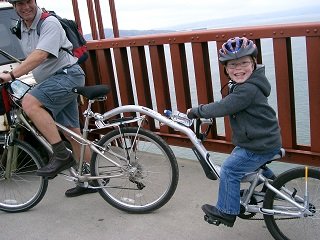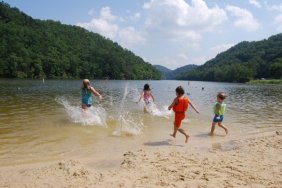 For many outdoors enthusiasts, sharing a love for nature and enjoying it in a variety of ways with their children is very important. It’s a great feeling to impart knowledge and see your children enjoy the trail or the water the same way you did when you were their age. One such activity that is easy to share and can be equally enjoyable for everyone involved is biking. Biking with your kids isn’t always as simply as strapping on a helmet and heading out, though, and today starts a series on biking with your children that I hope will make the process a lot smoother and more fun.
For many outdoors enthusiasts, sharing a love for nature and enjoying it in a variety of ways with their children is very important. It’s a great feeling to impart knowledge and see your children enjoy the trail or the water the same way you did when you were their age. One such activity that is easy to share and can be equally enjoyable for everyone involved is biking. Biking with your kids isn’t always as simply as strapping on a helmet and heading out, though, and today starts a series on biking with your children that I hope will make the process a lot smoother and more fun.
If you’re an avid cyclist and you plan on enjoying the activity with your children, it’s smart to get them started early. In this situation, early refers to getting them involved even before they can pedal. You can do this with a child bike seat, which attaches to the back of your bike seat. These seats are lightweight, but since they are attached, your child will fall if you do, so I would avoid rough terrain and make sure your child wears a helmet at all times.
Another popular option is a bike trailer, which are enclosed carriers that get towed behind your bike. They tend to be quite stable, easy to maneuver, and allow your child to rest and enjoy the ride while you pedal. Older children may get bored sitting in the trailer, though, and wish to hop on a bike of their own. In this case, it might be good to let them practice on a push bike, which has no chains or pedals, and allows them to push themselves along with their feet. This option would be limited to the yard or neighborhood, however.
Another way to allow your child to feel more active is a trailer bike, which attaches to your seatpost or rear rack, allowing it to pivot for turning. With a trailer bike, your child can pedal and feel independent, though they’re still relying on you for balance and control. This option is good for children between the four and seven age range who still might be a little unsure about cycling.
As your child grows, training wheels are the next step. Bikes with training wheels can give children the confidence boost to start riding on their own. Once the confidence is there, the training wheels can be removed. When buying a two-wheel bike for your child, keep in mind that children’s bikes are measured by their wheel size, not frame size. The right size is one where your child can comfortably get on the bike and stand with his or her feet on the ground. That being said, try to avoid the common mistake of buying a bike your child will grow into. This can cause problems while they’re learning to ride, since they’ll be adjusting to meet the needs of a bike that’s too big for them.
Sharing your passions with your children and watching them enjoy them over the years is one of the best parts of parenting, and cycling as a family is just one of many ways you can do this. The tips outlined above will help during the process and give you a good outline to stick with when gauging your child’s progress. Be sure to return for the next part of the series!








